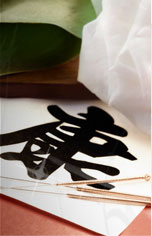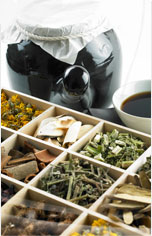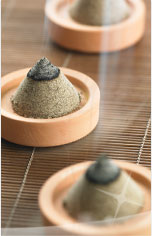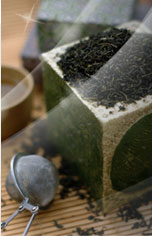| |
Acupuncture and Chinese Herbs for Breast Milk |

Motherhood is one of the most life-changing, joyous, and exciting phases of a woman’s life. However, the first few years of motherhood can bring unexpected worries. One of major concern that we often hear from new mothers is difficulty with breastfeeding.
Various factors can cause a low breast milk supply, such as waiting too long to start breast-feeding, not breast-feeding often enough, supplementing with formulas, an ineffective latch, and use of certain medications. Sometimes previous breast surgery affects the breast milk production. Other factors that can affect breast milk production include premature birth, maternal obesity, pregnancy-induced high blood pressure, and poorly controlled insulin-dependent diabetes.1
Maintaining your milk supply during breast-feeding is important for your baby's health and growth. Acupuncture and Chinese herbs can improve breast milk quantity and quality.
|
Breast Milk in TCM
TCM believes that breast milk is a product of transformation of Qi (the vital energy of the body) and Blood. Breast milk cannot be transformed without Qi, and it cannot be generated without the Blood. The smooth flow Qi is required to express breast milk from the nipples. Since Stomach meridian controls the breast and Liver meridian controls the nipples, it is important to maintain the free flow of Qi in these two meridians specifically.
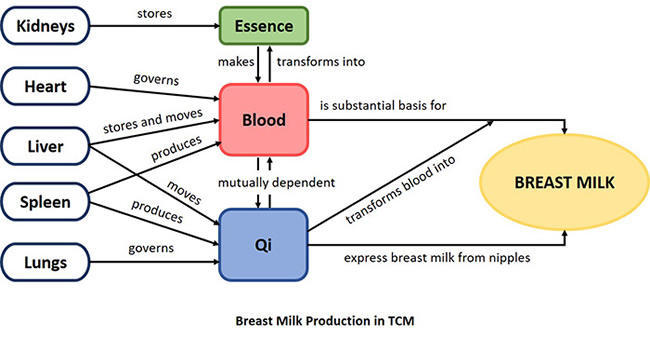
In TCM, there are two major causes of insufficient lactation. Breast milk may not be produced enough because of the deficiency of Qi and Blood; or there may be enough breast milk produced, but it does not flow properly because of stagnation of Qi in the breast. A long and difficult labor, profuse blood loss during labor, improper diet, or inadequate postpartum care lead to deficiency of Qi and Blood. Emotional imbalances such as excessive or prolonged worry, anger, frustration or resentment cause stagnation of Qi in the connecting meridians of the breast, leading to blockage of breast milk flow as well as distension and pain of the breast.
NOTE: The names of organs are capitalized when referring to the entire, functional organ systems in TCM perspective: Liver, Blood, etc. The names of organs are lower-cased when referring to the distinct, biomedical organs: liver, blood, etc.
TCM Treatment for Breast Milk Production
Acupuncture
Acupuncture treatments are primarily used to facilitate the circulation of Qi and Blood to enable the transformation of the Blood into breast milk and to express breast milk properly. Acupuncture is also very effective in reducing distension, fullness and pain in the breast caused by stagnation of Qi.
Research conducted at the Hanzhong Shanxi Hospital in China shows that using a specific set of acupuncture points significantly boosts lactation quantities. In a controlled investigation of 116 women with deficient secretion of breast milk, acupuncture successfully increased breast milk secretion from an average of 49.63 ml to 115.21 ml. In addition, lactating mothers who received acupuncture had a concomitant improvement in prolactin (a hormone that stimulates milk production) levels.2
Acupuncture involves the insertion of fine, sterile needles into specific acupuncture points on the body. Combinations of different acupuncture points are used depending on the primary cause of insufficient breast milk production and the overall condition of the patient.
Below are examples of acupuncture points commonly used for lactation. We often instruct patients to stimulate these points by applying firm pressure on the points bilaterally for 2-3 minutes about 5-10 minutes before breast-feeding or pumping to increase breast milk supply.
|
| |
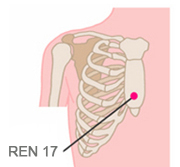 |
|
Ren 17 (Shan Zhong, Middle of the Chest) |
Location |
On the midline of the chest at the level with the fourth intercostal spaces |
Function |
Ren 17 opens the chest, benefits the breasts, boosts Qi, and enhances Blood flow to the chest |
|
| |
| |
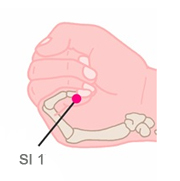 |
|
Si 1 (Shao Ze, Lesser Marsh) |
Location |
About 1mm from the base corner of the nail on the radial side of little finger |
Function |
Si 1 promotes lactation and benefits the breasts. This point is commonly used for insufficient lactation as well as any types of breast disorders, including mastitis, breast abscess, and cysts. |
|
| |
| |
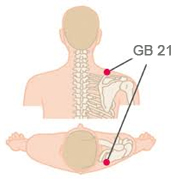 |
|
Gb 21 (Jian Jing, Shoulder Well) |
Location |
At the highest point of the shoulder, directly above the nipple |
Function |
Gb21 stimulates the letdown reflex and relieves tension and stress. It allows the oxytocin to flow and enables the breast tissue to be relaxed. This point also helps relieve the aches and pains from carrying the baby. |
|
|
| |
|
Chinese Herbal Medicine
While acupuncture focuses on facilitating the circulation of Qi and Blood, Chinese herbal formulas focus on tonifying Qi and Blood, the source of breast milk. Chinese herbs also restore any imbalances of internal organs to assist with healing and recovery after childbirth and to increase overall well-being. A randomized controlled trial published in 2018 concluded that a Chinese Herbal formula significantly enhanced breast-feeding success during the first week of postpartum.3
The Chinese herbs used commonly to increase breast milk production are:
- Pu Gong Ying (Dandelion)
- Dong Kui Zi (Musk Mallow seeds)
- Tong Cao (Tetrapanax, rice-paper plant pith)
- Wang Bu Liu Xing (Vaccaria seeds)
- Hei Zhi Ma (Black sesame seeds)
Chinese herbs are usually used in a combination of 2 to 30 herbs and are customarily prescribed for each patient. Herbs can be administered to a patient in many forms. Raw herbs can be taken on a brewed tea form. This herb tea form is strong and quick acting; however, it takes time for cooking and preparation and the taste can be quite strong initially. The herbs can also be prescribed in many other forms such as powder, capsule, pill, topical and tincture. Herbs possess many strengthening as well as therapeutic effects because of their content of various nutrients and vitamins, which are essential to the body. Patients usually notice a significant increase in breast milk production within 3-10 days of taking the herbal formulas.
Nutritional Advice
Childbirth and caring for a newborn can easily drain mother’s energy, which is essential for generating Blood and breast milk. Therefore, it is very important to get sufficient nutrients from a balanced diet which includes all essential amino acids (for proteins), fatty acid, minerals and vitamins that you need. Although the key point is eating a variety of vegetables, fruits, grains, protein, and healthy fat, the following list may give you an idea where to start.
|
|
Benefits of Breastfeeding for baby
- Increases immunity
- Reduces the chance of causing stomach upset, diarrhea and constipation than formula
- Reduces the risk of Sudden Infant Death Syndrome (SIDS)
- Reduces the chance of developing Celiac disease and inflammatory bowel disease
- Reduces the incidence of asthma, dermatitis, and eczema
- Reduces the rates of obesity and Type 1 Diabetes
- Improves cognitive development
- Helps bonding with mother
Benefits of Breastfeeding for Mom
- Lowers the risk of breast and ovarian cancer
- Promotes faster weight loss after birth
- Stimulates the uterus to contract and return to normal size
- Decreases the rate of postpartum depression
- Provides natural birth-control protection by delaying ovulation
- Helps bonding with baby
|
- Grains: barley, oats, and other whole grains
- Vegetables: artichoke, beets, broccoli, carrots, chard, garlic, kale, mushroom, onions, sweet potatoes, spinach
- Fruits: apple, apricot, avocado, banana, cherry, date, fig, oranges, papayas, red grapes
- Beans: black beans, kidney beans
- Nuts and seeds: almonds, black sesame, fennel seeds
- Seafood: mussel, oyster, salmon, sardine, tuna, seaweeds
- Meat and poultry: beef, pork, lamb, chicken, eggs
Fluid intake cannot be under-emphasized. It is crucial to be hydrated to create and sustain fluids in the body when producing breast milk. Besides drinking plenty of water throughout the day, a great way to get more hydration through foods is to try congee for breakfast. Congee is a traditional breakfast eaten in Asia, which harmonizes Spleen and Stomach and efficiently nourishes Body Fluids. Rice, barley, oatmeal, black sesame seeds, sweet potato, pumpkins, and many other grains and vegetables can be used to make congee.
Also, drinking bone broth can provide hydration and boost the nutrient content. In China, pig’s trotter broth is believed to be the best bone broth for increasing breast milk supply. In fact, pig’s trotters are used as one of the chief ingredient in most of ancient Chinese herbal formulas for breast milk production.
| |
Pig's Trotter Broth
Ingredient: 6 halved pig's trotters, salt, pepper, garlic, onion, other vegetables such as carrots and celery (optional)
Instructions

- Prepare the pig's trotters by washing thoroughly. Optionally, you can roast the pig's trotters, garlic, and onion in the oven for more robust flavor.
- Place the pig’s trotters in a heavy stockpot and cover them with enough water.
- Bring the pot to a boil over medium-high heat. Simmer at low heat, uncovered. Skim any foam that appears at the surface of the broth. Check the water level periodically and add more water if the water level drops too low.
- Once the cartilage of pig's trotter has liquified and the water has turned to milky white color (it usually takes about 2 hours), add garlic, onion, and other vegetables and cook for about 30 more minutes at medium-high heat.
- Strain the broth, and lightly season with salt and pepper.
- Drink 1 cup of warm pig's trotter broth about 30-45 minutes before nursing the baby.
|
|
|
|
|

